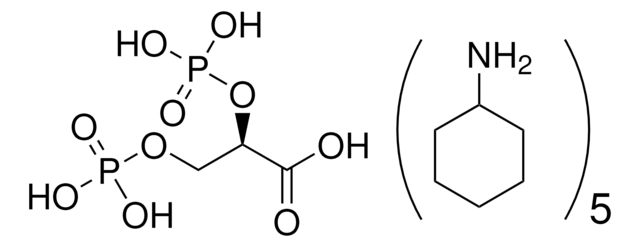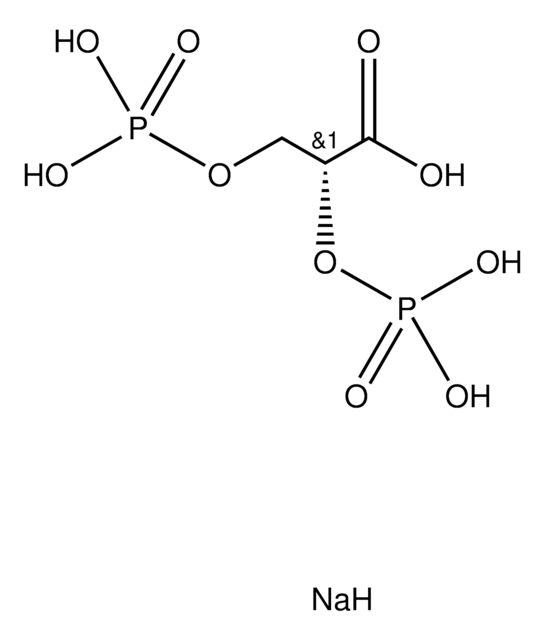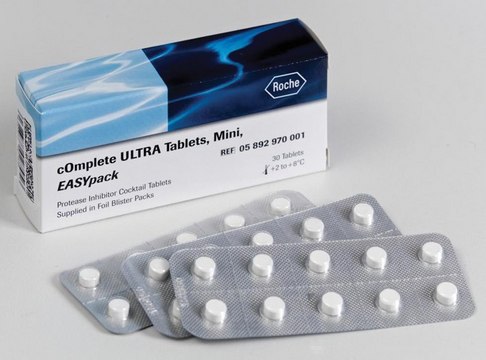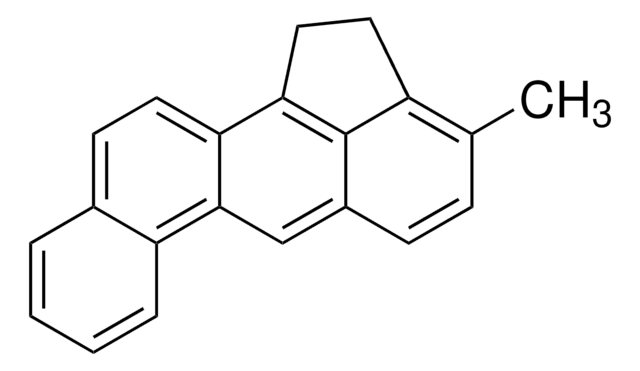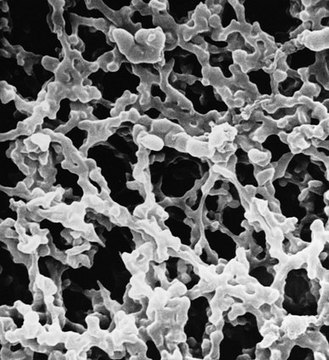10148334001
Roche
2,3-Diphosphoglycerate (2,3-DPG)
Synonym(s):
2,3-dpg, glycerate-2,3-biphosphate, test combination
Sign Into View Organizational & Contract Pricing
All Photos(1)
About This Item
UNSPSC Code:
12352200
Recommended Products
usage
sufficient for ~30 tests
manufacturer/tradename
Roche
shipped in
wet ice
storage temp.
2-8°C
General description
UV-test for the determination of 2,3-DPG in blood research samples.
Note: In addition, perchloric acid as auxiliary reagent is required.
Note: In addition, perchloric acid as auxiliary reagent is required.
Application
The test is used for the determination of 2,3-diphosphoglycerate in blood in the range of 0.02 to 0.15 μmol in life science research applications.
2,3-diphosphoglycerate (2,3-DPG) kit has been used to determine the levels of 2,3 DPG and ATP in fresh and stored human red blood cells.
2,3-diphosphoglycerate (2,3-DPG) kit has been used to determine the levels of 2,3 DPG and ATP in fresh and stored human red blood cells.
Biochem/physiol Actions
2,3-diphosphoglycerate (2,3-DPG) in red blood cells (RBC) determines the ease with which hemoglobin releases oxygen in the tissues. The higher the level of erythrocytic 2,3DPG, the lower is the affinity to oxygen and vice versa. pH levels during acid-base disorder influence oxygen affinity by affecting both 2,3-DPG metabolism and oxyhaemoglobin dissociation curve. Intracellular 2,3DPG concentrations are influenced by phosphate levels, and low erythrocyte levels of 2,3DPG are linked with hypophosphatemia.
Packaging
1 kit containing 5 components.
Preparation Note
Stabilizers: EDTA contained in the buffer solution of bottle 1 of the 2,3-Diphosphoglycerate Test Kit stabilizes enzymes when dissolved in this buffer.
Note: In addition, perchloric acid as auxiliary reagent is required.
Note: In addition, perchloric acid as auxiliary reagent is required.
Other Notes
For life science research only. Not for use in diagnostic procedures.
Kit Components Only
Product No.
Description
- Triethanolamine buffer, pH 7.6, with MgCl2 and EDTA
- ATP and NADH, 2 bottles
- PGM, PGK, GAP-DH, TIM and GDH, lyophilizate
- Phosphoglyceratemutase (PGM), lyophilizate
- Glycolate-2-phosphate, tricyclohexylammonium salt
Signal Word
Warning
Hazard Statements
Precautionary Statements
Hazard Classifications
Acute Tox. 4 Inhalation - Eye Irrit. 2
Storage Class Code
12 - Non Combustible Liquids
WGK
WGK 2
Flash Point(F)
does not flashNot applicable
Flash Point(C)
does not flashNot applicable
Regulatory Information
监管及禁止进口产品
Choose from one of the most recent versions:
Already Own This Product?
Find documentation for the products that you have recently purchased in the Document Library.
R MacDonald
Anaesthesia, 32(6), 544-553 (1977-06-01)
The ease with which haemoglobin releases oxygen to the tissues is controlled by erythrocytic 2,3-diphosphoglycerate (2,3-DPG) such that an increase in the concentration of 2,3-DPG decreases oxygen affinity and vice versa. This review article describes the synthesis and breakdown of
N J Raat et al.
Critical care medicine, 33(1), 39-45 (2005-01-13)
To determine whether the storage time of human leukodepleted red blood cell concentrates compromises intestinal microvascular oxygen concentration oxygen (muPo(2)) during isovolemic exchange transfusion at low hematocrit. Prospective, randomized, controlled study. University research institute laboratory. Male Wistar rats. Intestinal muPo(2)
Shilpa Sharma et al.
Clinical journal of the American Society of Nephrology : CJASN, 10(1), 74-79 (2014-12-30)
Hypophosphatemia is a frequent complication during continuous renal replacement therapy (CRRT), a dialytic technique used to treat AKI in critically ill patients. This study sought to confirm that phosphate depletion during CRRT may decrease red blood cell (RBC) concentration of
Our team of scientists has experience in all areas of research including Life Science, Material Science, Chemical Synthesis, Chromatography, Analytical and many others.
Contact Technical Service